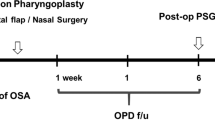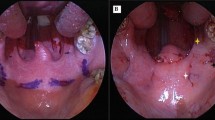Abstract
Recent studies have shown that lateral pharyngoplasty is an effective procedure to correct obstructive sleep apnea. The objective of the paper was to evaluate factors contributing to obstructive sleep apnea syndrome and identify the different severity categories of obstructive sleep apnea that could benefit from lateral pharyngoplasty. We included 60 patients undergoing uvulopalatopharyngoplasty with or without lateral pharyngoplasty from December 1, 2008 to May 31, 2012. Six who did not complete the post-operative survey were excluded. 54 participants were assigned alternatively to either uvulopalatopharyngoplasty alone (control group, n = 29) or to uvulopalatopharyngoplasty with lateral pharyngoplasty (intervention group, n = 25). The reduction of apnea–hypoxia index in the intervention group (49.3 %) was higher than it was in the control group (30.4 %), but the average value was not statistically significant (p = 0.088). Only patients with moderate obstructive sleep apnea in the intervention group achieved a significant reduction of apnea–hypoxia index (30.7 vs. 10.8 %; p = 0.020). Factors such as body mass index, nadir/mean SpO2, snoring index, Epworth sleepiness scale and periodic limb movement index did not change significantly following lateral pharyngoplasty. To evaluate patients’ upper airway anatomy, we employed cephalometry, and found that the retroglossal space played a critical role in severe obstructive sleep apnea. Our study showed that only patients in the moderate category can be benefited from adding lateral pharyngoplasty to uvulopalatopharyngoplasty; however, patients in the mild or severe category did not benefit from adding this procedure. This information is vital when considering surgery for patients with obstructive sleep apnea syndrome.
Level of evidence Prospective cohort study, Level II.



Similar content being viewed by others
References
Schwab RJ, Gefter WB, Hoffman EA, Gupta KB, Pack AI (1993) Dynamic upper airway imaging during awake respiration in normal subjects and patients with sleep disordered breathing. Am Rev Respir Dis 148:1385–1400
Schwab RJ, Gupta KB, Gefter WB, Metzger LJ, Hoffman EA, Pack AI (1995) Upper airway and soft tissue anatomy in normal subjects and patients with sleep-disordered breathing: significance of the lateral pharyngeal walls. Am J Respir Crit Care Med 152:1673–1689
Nisha AR, Kenneth RC, Kristo D et al (2010) Practice parameters for the surgical modifications of the upper airway for obstructive sleep apnea in adults. Sleep 33(10):1408–1413
Fujita S, Conway W, Zorick F, Roth T (1981) Surgical correction of anatomic abnormalities in obstructive sleep apnea syndrome: uvulopalatopharyngoplasty. Otolaryngol Head Neck Surg 89:923–934
Shin SH, Ye MK, Kim CG (2009) Modified uvulopalatopharyngoplasty for the treatment of obstructive sleep apnea–hypopnea syndrome: resection of the musculus uvulae. Otolaryngol Head Neck Surg 140(6):924–929
Kezirian EJ, Weaver EM, Yueh B, Deyo RA, Khuri SF, Daley J et al (2004) Incidence of serious complications after uvulopalatopharyngoplasty. Laryngoscope 114(3):450–453
Michel BC, Gilberto GSF, Eloisa MMS, Gebrim EM, Miziara ID (2004) Lateral pharyngoplasty versus uvulopalatopharyngoplasty: a clinical, polysomnographic and computed tomography measurement comparison. Sleep 27:942–950
Bican A, Kahraman A, Bora I, Kahveci R, Hakyemez B (2010) What is the efficacy of nasal surgery in patients with obstructive sleep apnea syndrome? J Craniofac Surg 21:1801–1806
David ER, Michael GS (2010) Is nasal surgery an effective treatment for obstructive sleep apnea? Laryngoscope 120:1496–1497
Cahali MB (2003) Lateral pharyngoplasty: a new treatment for obstructive sleep apnea hypopnea syndrome. Laryngoscope 113:1961–1968
Soares D, Sinawe H, Adam JF et al (2012) Lateral oropharyngeal wall and supraglottic airway collapse associated with failure in sleep apnea surgery. Laryngoscope 122:473–479
Babademez MA, Yorubulut M, Yurekli MF et al (2011) Comparison of minimally invasive techniques in tongue base surgery in patients with obstructive sleep apnea. Otolaryngol Head Neck Surg 145(5):858–864
Richard MD, Richard F (2009) Clinical foundation for efficient treatment of obstructive sleep apnea. J Oral Maxillofac Surg 67:2171–2182
Stacey LI, Roxann MC, Tiffany LM, Christine GG (2010) Depression, sleepiness, and disease severity in patients with obstructive sleep apnea. Laryngoscope 120:2331–2335
Roop K, Vinay P, Esteban W, Anuradha R, Nancy FS (2012) Postoperative complications in patients with obstructive sleep apnea. Chest 141(2):436–441
Mihaela T, David AP, Stephanie VH et al (2010) Association of obstructive sleep apnea risk with asthma control in adults. Chest 138(3):543–550
Adebola OA, Won L, Nancy BG, Girish PJ (2010) Perioperative management of obstructive sleep apnea. Chest 138(6):1489–1498
Kasey KL, Clete K, Nelson BP, Robert WR, Christian G (2000) Obstructive sleep apnea syndrome: a comparison between far-east Asian and white men. Laryngoscope 110:1689–1693
Tsai YJ, Ramar K, Liang YJ et al (2013) Peripheral neuropathology of the upper airway in obstructive sleep apnea syndrome. Sleep Med Rev 17(2):161–168
Yaggi HK, Kingman PS (2010) Adult obstructive sleep apnea/hypopnea syndrome: definitions, risk factors, and pathogenesis. Clin Chest Med 31:179–186
Richard JS, Michael P, Robert P et al (2003) Identification of upper airway anatomic risk factors for obstructive sleep apnea with volumetric magnetic resonance imaging. Am J Respir Crit Care Med 168:522–530
Sonia MGP, Togeiro SM, Cauby MC et al (2010) Evaluation of the upper airway in obstructive sleep apnoea. Indian J Med Res 131:230–235
Liao YF, Chuang ML, Huang CS, Tsai YY (2004) Upper airway and its surrounding structures in obese and nonobese patients with sleep-disordered breathing. Laryngoscope 114:1052–1059
Chiang PY, Lin CM, Nelson P, Chiang YC, Tsai YJ (2012) Systematic analysis of cephalometry in obstructive sleep apnea in Asian children. Laryngoscope 122:1867–1872
Osnes T, Rollheim J, Hartmann E (2002) Effect of UPPP with respect to site of pharyngeal obstruction in sleep apnoea: follow-up at 18 months by overnight recording of airway pressure and flow. Clin Otolaryngol 27:38–43
Reginald G (2009) Diagnosis, treatment planning, and surgical correction of obstructive sleep apnea. J Oral Maxillofac Surg 67:2183–2196
Neil F (2010) Treatment of obstructive sleep apnea syndrome. Clin Chest Med 31:187–201
Melanie AS, Scott S, Bryn S, Chris D (2004) Upper airway surgery benefits patients with obstructive sleep apnoea who cannot tolerate nasal continuous positive airway pressure. J Laryngol Otol 118:270–274
Schendel S, Powell N, Jacobson R (2011) Maxillary, mandibular, and chin advancement: treatment planning based on airway anatomy in obstructive sleep apnea. J Oral Maxillofac Surg 69(3):663–676
Babademez MA, Yorubulut M, Yurekli MF et al (2011) Comparison of minimally invasive techniques in tongue base surgery in patients with obstructive sleep apnea. Otolaryngol Head Neck Surg 145(5):858–864 Epub 2011 Aug 8
Edward M, Weaver B, Tucker W et al (2011) Studying life effects and effectiveness of palatopharyngoplasty (SLEEP) study: subjective outcomes of isolated uvulopalatopharyngoplasty. Otolaryngol Head Neck Surg 144:623–631
Lee HY, Lee LA (2009) Relocation pharyngoplasty for obstructive sleep apnea. Laryngoscope 119:2472–2477
Powell N, Riley R, Guilleminault C, Troell R (1996) A reversible uvulopalatal flap for snoring and sleep apnea syndrome. Sleep 19(7):593–599
Conflict of interest
None.
Author information
Authors and Affiliations
Corresponding author
Rights and permissions
About this article
Cite this article
Chi, J.CY., Chiang, R.PY., Chou, TY. et al. The role of lateral pharyngoplasty in obstructive sleep apnea syndrome. Eur Arch Otorhinolaryngol 272, 489–496 (2015). https://doi.org/10.1007/s00405-014-3253-6
Received:
Accepted:
Published:
Issue Date:
DOI: https://doi.org/10.1007/s00405-014-3253-6




